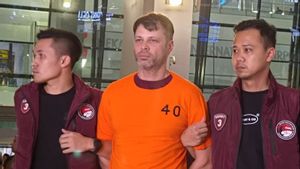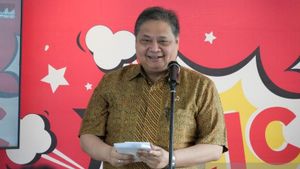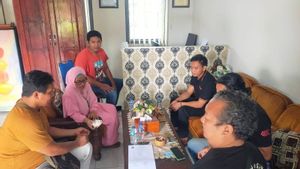JAKARTA - Prison space in a fort is commonplace. The function of the fort as a center of military power is the estuary. Fort (fort) Rotterdam, for example. Starting from the Bongaya agreement, Fort Rotterdam is like a symbol of the domination of Dutch colonialism in Makassar. The fort, which was originally called Ujung Pandang, has the oldest prison room in the archipelago.
Prince Diponegoro became the most famous person to have lived in prison in the fort. No kidding, for 22 years. Fort Rotterdam and the Kingdom of Gowa-Tallo are two things that cannot be separated. The two are interrelated. The fort which was originally called Ujung Pandang Fort was built by the 10th King of Gowa, I Manrigau Daeng Bonto Karaeng Lakiung with the title Karaeng Tunipalangga Ulaweng in 1545.
This fort was built with a characteristic like most Portuguese forts: rectangular in shape. The material of manufacture is dominated by clay. Then, when Sultan Alauddin ascended the throne, the new fort was replaced with a rock from the Karst mountains in the Maros area in 1634. The appearance of the Ujung Pandang fort became the new strength of Gowa-Tallo.
Because, previously Gowa-Tallo already had 14 strong and closed forts to ward off sudden enemy attacks. In addition, Fort Rotterdam has the function of controlling trade and economic transactions which are the main pillars of the life and existence of the kings of Goa-Tallo. Therefore, the Dutch trading airline, the VOC, which had the intention of monopolizing the Nusantara trade, felt threatened by the political and economic position of the Kingdom of Goa-Tallo.

“The strong political and economic position of the Makassar Kingdom became a major threat to the VOC, which carried out a monopoly policy. The conflict and hostility between them, which lasted from 1615, culminated in the Makassar War from December 1666 to November 18, 1667. The VOC prevailed and succeeded in forcing Makassar to sign the Treaty of Bongaya (Het Bongaais Verdrag). This peace agreement is very beneficial for the VOC,” wrote Edward L. Poelinggomang in the book Makassar XIX Century (2016).
The victory was thanks to the Governor General of the VOC, Joan Maetsuycker (1653-1678) who sent the breaker of the Kingdoms of the Archipelago, Cornelis Speelman. The figure who later became the 14th Governor General of the VOC became the strategist for the attack on Makassar. Speelman's fleet consisted of 21 ships with a force of 300 European troops. That power is small. However, the VOC also brought with it reserve troops from the Bumiputras under the command of Captain Jonker and some of the followers of Arung Palakka from Bone.
The persistent battle made the King of Gowa-Tallo surrender. Even after that, the king, Sultan Hasanuddin, was forced to sign the Bongaya peace treaty. This agreement became a tool for the Dutch to establish their power in Makassar. The kingdom was forced to pay war losses, release prisoners of VOC employees, and dismantle existing fortifications, except for the Ujung Pandang fort. Which, the Fort Ujung Pandang was renamed by the Dutch to Fort Rotterdam.
“The Bongaya Agreement brought about a revolutionary change in political organization in the eastern part of the Indonesian Archipelago. The Company obtained a trade monopoly in the port of Makassar and all non-Dutch Europeans were forced to leave the city. An even greater consequence is the limitation on Makassar's sphere of interest which has been strictly reduced to include the city itself and its surroundings.”
“Even in this small area the Company has power and is allowed to own Fort Rotterdam, while Dutch coins are declared to have legal value in that country. All territory released by Makassar automatically fell into the hands of the Company, although for practical reasons it was placed under the nominal power of local kings,” said Bernard HM Vlekke in the book Nusantara (1961).
The oldest prison inside Fort Rotterdam
After the war, the VOC did not only repair the fort. Instead, they built many additional facilities and infrastructure according to Dutch architectural tastes. The fort that used to be the pillar of the kingdom's economic activities, has now become a symbol of the VOC's military power. Especially, when infrastructure was added so that it fulfilled the function of the fort as a Dutch settlement and also a center of military power in Makassar land.
In it there is also a place to enforce political power and the VOC. A series of torture chambers and prisons were later added by the VOC. The facility is considered important because Speelman himself has a lot of bad images. He is often involved in selling slaves, cheating, being corrupt, and often imprisoning people without solid evidence.
Some of these fighters who fought against Dutch domination were exiled and placed in prison in the fort. Therefore, it is not uncommon for prisons to be occupied beyond their proper capacity. Moreover, prisons are overcrowded because many people have not been brought to justice.
“Therefore, in the fort prior to the existence of the new villages, a social settlement was formed for the physical and spiritual needs of the residents of the fort. In this fort, the VOC not only built infrastructure that was used to fulfill its economic interests, but also provided worship facilities for VOC officials and employees.”
“Apart from that there is also room to try, imprison and torture the prisoners who were brought to the fort. This proves that the function of the fort was as a support for the political and legal power of the VOC at that time,” said Djoko Marihandono in his writing in the Discourse Journal entitled Changes in the Role and Function of the Benteng (2008).

One of those who had languished in prison in a fort was the figure who instigated the Java War (1825-1830), Prince Diponegoro. Previously, Diponegoro was languishing in Fort Nieuw Amsterdam, Manado. Diponegoro was there from June 1830 to June 1833. Finally, Diponegoro was relocated to Fort Rotterdam with his wife and 22 loyal followers. He himself occupied a narrow prison. The Dutch also forbade Diponegoro to leave the fort and receive guests without the consent of the Dutch.
He had wanted to be relocated again by the Dutch colonial government. Diponegoro refused. He chose to spend the rest of his life in Fort Rotterdam. It is recorded that Diponegero spent 22 years in Fort Rotterdam, from 12 July 1833 to 8 January 1855.
“Princes may exercise with guard inside the fort but only in the hours between sunrise and sunset. By the time the sun went down, the garrison commander had to check if he and his followers had returned to their place. No one may visit the Prince except with the written permission of the Governor."
“The only exceptions were the commander, the officer in charge of the guard, and the senior Dutch interpreter for the Malay language. Special attention is needed so that Diponegoro and his followers do not establish relationships with local indigenous soldiers, servants, or exiles and members of the forced labor who serve in the fort,” concluded Peter Carey in the book Power of Divination: Prince Diponegoro and the End of the Old Order in Java. 1785-1855 (2012).
*Read other information about HISTORY or read other interesting articles from Detha Arya Tifada.
Other MEMORIESThe English, Chinese, Japanese, Arabic, and French versions are automatically generated by the AI. So there may still be inaccuracies in translating, please always see Indonesian as our main language. (system supported by DigitalSiber.id)











